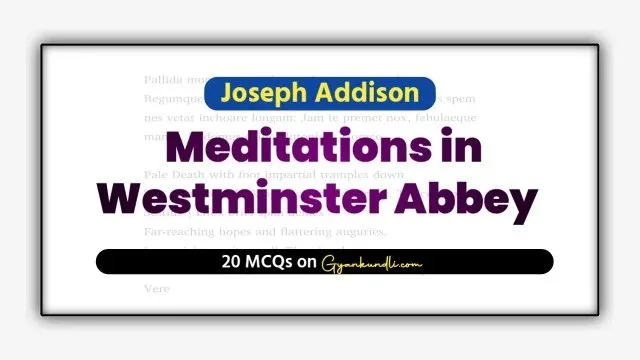“Daffodils” by William Wordsworth is a quintessential Romantic poem that vividly celebrates the beauty and emotional impact of nature. The poem describes the speaker’s encounter with a field of daffodils and how this experience brings joy and inspiration, leaving an enduring imprint on his memory and emotions. It’s a testament to the transformative power of nature and the human connection to the natural world.

Text of the poem “Daffodils”
I wandered lonely as a cloud
That floats on high o’er vales and hills,
When all at once I saw a crowd,
A host, of golden daffodils;
Beside the lake, beneath the trees,
Fluttering and dancing in the breeze.
Continuous as the stars that shine
And twinkle on the milky way,
They stretched in never-ending line
Along the margin of a bay:
Ten thousand saw I at a glance,
Tossing their heads in sprightly dance.
The waves beside them danced; but they
Out-did the sparkling waves in glee:
A poet could not but be gay,
In such a jocund company:
I gazed—and gazed—but little thought
What wealth the show to me had brought:
For oft, when on my couch I lie
In vacant or in pensive mood,
They flash upon that inward eye
Which is the bliss of solitude;
And then my heart with pleasure fills,
And dances with the daffodils.
About the Poet “William Wordsworth”
William Wordsworth (1770-1850) was a renowned English poet, often considered one of the founders of the Romantic literary movement. Here are some key points about his life and contributions:
Early Life: Wordsworth was born in Cockermouth, Cumberland, England. He had a somewhat turbulent childhood, marked by the early loss of his mother and father. These experiences would later influence his poetry.
Education: He attended Cambridge University and was exposed to the intellectual and literary currents of the time. His experiences in nature and exposure to radical political ideas during this period had a profound impact on his writing.
Romantic Poet: Wordsworth is often regarded as one of the central figures of the Romantic movement in English literature. The Romantics celebrated nature, emotion, and the individual’s inner world. Wordsworth’s works, like “Daffodils” and “Lines Composed a Few Miles Above Tintern Abbey,” exemplify these themes.
Lyrical Ballads: He, along with Samuel Taylor Coleridge, published “Lyrical Ballads” in 1798, a groundbreaking collection of poems that marked the beginning of English Romantic poetry. The preface to this collection, written by Wordsworth, is considered a manifesto of Romantic poetry.
Nature and Simplicity: Wordsworth’s poetry often focused on nature and rural life. He believed in the spiritual and moral influence of nature on human beings. His style was characterized by simplicity and the use of everyday language.
Lake Poets: Wordsworth, along with Coleridge and Robert Southey, is sometimes referred to as one of the “Lake Poets” because they lived in the Lake District of England, an area known for its natural beauty, which greatly influenced their work.
Later Life: In his later years, Wordsworth served as the Poet Laureate of the United Kingdom. He continued to write poetry and prose, including his autobiographical work “The Prelude.”
Legacy: Wordsworth’s poetry had a profound influence on subsequent generations of poets and writers. He is remembered for his celebration of the sublime in nature, the power of imagination, and the inner world of the individual. His emphasis on the ordinary and his belief in the moral and spiritual benefits of nature had a lasting impact on English literature.
William Wordsworth‘s contributions to the Romantic movement and English literature as a whole have solidified his status as one of the most important poets in the literary canon. His works continue to be studied and celebrated for their enduring themes and beautiful language.
Literary and Historical Context of “Daffodils”
“Daffodils,” also known as “I Wandered Lonely as a Cloud,” is a famous poem by the English Romantic poet William Wordsworth, published in 1807. It’s important to understand the literary and historical context in which this poem was written:
Romanticism: Wordsworth was a key figure in the Romantic literary movement, which emerged in the late 18th century as a reaction against the Industrial Revolution and the Enlightenment. Romantic poets celebrated nature, emotion, and the individual’s inner world. “Daffodils” reflects the Romantic focus on the beauty and emotional impact of the natural world.
The Industrial Revolution: Wordsworth lived during a time of significant societal changes. The Industrial Revolution was transforming England into an industrialized nation, leading to urbanization and a disconnection from nature. Wordsworth’s poetry often sought to reestablish a connection with the natural world, as seen in “Daffodils.”
The French Revolution: The late 18th century was a period of political upheaval, with the French Revolution (1789-1799) having a profound impact on Europe. Wordsworth initially supported the French Revolution’s ideals of liberty and equality, but he became disillusioned as the revolution turned violent. His poetry often reflects his changing political and philosophical views.
Nature and Solitude: “Daffodils” is a poem that reflects Wordsworth’s personal experience of encountering a field of daffodils while wandering in the Lake District of England. It emphasizes the restorative power of nature and the solace one can find in it. The poem also explores the idea of the interconnectedness of nature and human emotions.
Publication and Reception: The poem was first published in 1807 in “Poems in Two Volumes” and was met with mixed reviews. It wasn’t until later that it gained widespread popularity and acclaim, becoming one of Wordsworth’s most celebrated works.
In “Daffodils,” Wordsworth’s use of nature and vivid imagery to convey a sense of tranquility and inspiration is a quintessential example of Romantic poetry. It highlights the poet’s desire to find meaning and solace in the natural world, which is a central theme of his body of work.
Setting of the poem “Daffodils”
The setting of the poem “Daffodils” by William Wordsworth is a picturesque natural landscape. The poem vividly describes a field of golden daffodils in the countryside, near a lake. Wordsworth’s description evokes a sense of serenity and natural beauty. Here’s an excerpt from the poem that describes the setting:
“Ten thousand I saw at a glance,
Tossing their heads in sprightly dance.
The waves beside them danced, but they
Outdid the sparkling waves in glee.”
This setting, with the daffodils “fluttering and dancing” in the breeze, is integral to the poem’s theme of the restorative and uplifting power of nature. It portrays a tranquil and idyllic scene in the English Lake District, a region known for its natural beauty and which was a significant source of inspiration for Wordsworth’s poetry.
Summary of the poem “Daffodils”
“Daffodils,” also known as “I Wandered Lonely as a Cloud,” is a famous poem by William Wordsworth. The poem is a lyrical reflection on the beauty and impact of nature. Here’s a summary:
The poem begins with the speaker (Wordsworth) describing how he was wandering alone like a drifting cloud, feeling lonely and disconnected from the world. He stumbles upon a field of golden daffodils beside a lake. The daffodils are in full bloom, stretching along the shore in a seemingly endless line. They dance and flutter in the breeze, creating a mesmerizing sight.
The sight of the daffodils has a profound effect on the speaker. He is struck by the beauty and liveliness of the scene. The memory of the daffodils’ dance and their continuous presence flashes into his mind whenever he feels lonely or in a pensive mood. The memory of the scene becomes a source of comfort and solace for him.
The poem highlights the idea that nature has the power to uplift the human spirit and provide solace in times of loneliness and contemplation. It also underscores the idea that these moments of natural beauty can have a lasting impact on our lives, serving as a source of inspiration and comfort in our memories.
In essence, “Daffodils” is a celebration of the beauty of the natural world and its ability to bring joy and inspiration to our lives, even in moments of solitude and introspection. It’s a quintessential Romantic poem, emphasizing the connection between nature and the human soul.
Theme of the poem “Daffodils”
The central theme of the poem “Daffodils” by William Wordsworth is the transformative and uplifting power of nature. The poem explores several related themes:
The Beauty of Nature: The poem extols the beauty of the natural world, particularly the field of daffodils that the speaker encounters. It vividly describes the daffodils as “dancing” and “fluttering” in the breeze, painting a picture of natural splendor.
Inspiration and Joy: Wordsworth conveys the idea that nature has the capacity to inspire and bring joy to the human spirit. The sight of the daffodils fills the speaker with a sense of wonder and happiness, which stays with him even in moments of solitude.
Solitude and Loneliness: The poem begins with the speaker feeling lonely and disconnected from the world. The encounter with the daffodils serves as a remedy for his loneliness. It suggests that nature can provide solace and alleviate feelings of isolation.
The Power of Memory: The memory of the daffodils continues to uplift the speaker’s mood long after the initial encounter. This highlights the enduring impact of beautiful natural experiences and how they can be a source of solace and inspiration in the future.
The Connection Between Nature and the Human Spirit: “Daffodils” is a quintessential Romantic poem, emphasizing the profound connection between the natural world and the emotions and inner life of the individual. It suggests that nature can act as a source of spiritual and emotional nourishment.
Overall, the poem celebrates the idea that nature, with its beauty and vitality, has the ability to transform one’s mood and inspire a sense of joy and connection, even in moments of solitude and contemplation.
Quiz on : Daffodils by William Wordsworth : 30 MCQs Quiz
Symbols in “Daffodils”
In William Wordsworth’s poem “Daffodils,” there are several symbolic elements that enhance the meaning and themes of the poem:
Daffodils: The daffodils themselves are a powerful symbol in the poem. They symbolize the beauty and vitality of nature. Their abundance and cheerful, dancing movements represent the abundance and vivacity of nature, which has the power to uplift the human spirit.
Continuous Line of Daffodils: The image of the “continuous” line of daffodils stretching along the shore symbolizes the idea of a continuous, unbroken connection between humanity and the natural world. It suggests that nature is always present and can be a source of inspiration, even in moments of solitude.
Comparison to Stars: When the speaker compares the daffodils to stars, it symbolizes the idea that the beauty of nature rivals the beauty and wonder of the night sky. It reinforces the notion that nature is a source of awe and inspiration.
The “Inward Eye”: The phrase “inward eye” symbolizes the power of memory and imagination. It suggests that the memory of the daffodils can be an inner source of comfort and inspiration, accessible to the speaker even when he is physically distant from the scene.
The Dance of the Daffodils: The dance of the daffodils symbolizes the dynamic and joyful aspect of nature. Their dance is a metaphor for the vibrancy and liveliness of the natural world, which has the ability to bring happiness to the observer.
These symbolic elements come together to convey the poem’s central theme: the transformative and uplifting power of nature on the human spirit, and how the memory of such natural beauty can remain a source of inspiration and solace.
Explanation & Analysis of “Daffodils”
“Daffodils,” also known as “I Wandered Lonely as a Cloud,” by William Wordsworth is a lyric poem that vividly describes a personal encounter with a field of daffodils and explores the emotional and philosophical impact of that experience. Here is an explanation and analysis of the poem:
Explanation:
The poem begins with the speaker describing how he was wandering aimlessly, feeling lonely and isolated, much like a drifting cloud. He stumbles upon a field of daffodils beside a lake. The daffodils are described as “fluttering and dancing in the breeze,” creating a mesmerizing sight. The memory of this scene continues to fill the speaker’s heart with joy and inspiration whenever he feels lonely or introspective.
Analysis:
Nature as a Source of Joy: The poem celebrates the idea that nature has the power to bring joy and inspiration to the human spirit. The daffodils are personified as “dancing” and “fluttering,” and their lively movement is contrasted with the solitary and melancholic state of the speaker at the beginning of the poem. This contrast emphasizes the transformative power of nature.
Memory and Imagination: Wordsworth places a strong emphasis on the role of memory and imagination. The memory of the daffodils continues to uplift the speaker even when he is physically separated from them. This underscores the idea that the human mind can draw on the beauty of nature as a source of solace and inspiration.
Connection to the Romantic Movement: “Daffodils” is a quintessential Romantic poem. It exemplifies the Romantic focus on nature, emotion, and the individual’s inner world. Wordsworth, a key figure of the Romantic literary movement, often celebrated the beauty and spiritual significance of nature in his works.
The Power of Simplicity: The poem is written in a simple, straightforward language, which is characteristic of Wordsworth’s style. This simplicity enhances the accessibility and universality of the poem, making it relatable to a wide audience.
Transcendental Moments: The encounter with the daffodils is a “transcendental” moment for the speaker. It takes him out of his mundane, lonely state and connects him to something larger and more profound. This is a central idea in Romantic literature, where nature often serves as a bridge between the ordinary and the extraordinary.
In “Daffodils,” Wordsworth captures the essence of the Romantic movement by emphasizing the profound connection between the natural world and the human soul. The poem’s enduring popularity lies in its ability to resonate with readers and remind them of the power of nature to bring joy and inspiration, even in moments of solitude and reflection.
Form, Meter, & Rhyme Scheme of “Daffodils”
“Daffodils” by William Wordsworth is a lyric poem that follows a specific form, meter, and rhyme scheme. It is composed of four six-line stanzas, making it a total of 24 lines.
Form: The poem is written in a regular, consistent form, with each stanza having six lines. This form is often referred to as a “sestet”.
Meter: The poem predominantly follows iambic tetrameter, which means each line typically consists of four metrical feet (iambic), with each foot consisting of one unstressed syllable followed by one stressed syllable. However, there are some variations in the poem.
Rhyme Scheme: The rhyme scheme of the poem is ABABCC for each stanza, which means that the first and third lines of each stanza rhyme with each other (A), the second and fourth lines rhyme with each other (B), and the last two lines of each stanza rhyme with each other (C).
Here’s an example of the rhyme scheme in the first stanza:
I wandered lonely as a cloud (A)
That floats on high o’er vales and hills (B)
When all at once I saw a crowd (A)
A host, of golden daffodils (B)
Fluttering and dancing in the breeze (C)
Continuous as the stars that shine (C)
This consistent form, meter, and rhyme scheme contribute to the poem’s musical and flowing quality, which is characteristic of many of Wordsworth’s lyrical works. It helps create a sense of harmony and beauty in the language, which complements the poem’s celebration of the natural world.
Poetic Devices & Figurative Language in “Daffodils”
In “Daffodils” by William Wordsworth, several poetic devices and figurative language techniques are used to enhance the imagery and meaning of the poem. Here are some of the prominent ones:
Simile: The poem opens with a simile, “I wandered lonely as a cloud,” which compares the speaker’s aimless wandering to that of a cloud. This simile sets the tone for the poem’s contemplative and reflective mood.
Personification: Wordsworth personifies the daffodils by describing them as “dancing” and “fluttering in the breeze.” This personification gives the daffodils a sense of life and animation, making them seem like joyful, living beings.
Imagery: The poem is rich in vivid imagery, such as “Ten thousand I saw at a glance,” and “Continuous as the stars that shine.” This imagery allows the reader to visualize the profusion of daffodils and their comparison to stars in the night sky.
Metaphor: The comparison of the daffodils to stars is also a metaphor. This metaphor highlights the idea that the daffodils are not just beautiful but also possess a transcendent quality, like celestial bodies.
Hyperbole: The speaker uses hyperbole when he describes the daffodils as “ten thousand” and “never-ending.” These exaggerations emphasize the abundance and profusion of the daffodils, creating a sense of wonder.
Enjambment: The poem uses enjambment, where sentences or clauses continue from one line to the next without a pause. This technique creates a sense of flow and continuity in the poem, mirroring the continuous and unbroken line of daffodils.
Oxymoron: The poem presents an interesting paradox or oxymoron with the idea of a “jocund company” of daffodils. “Jocund” means cheerful or merry, while “company” implies a gathering of people. This oxymoron captures the joyful and sociable nature of the daffodils.
These poetic devices and figurative language techniques contribute to the poem’s beauty, emotional depth, and ability to capture the reader’s imagination. Wordsworth‘s skillful use of these elements creates a lasting and vivid impression of the scene and the emotional impact it has on the speaker.
Also read : English Grammar in Use Book Review
Discover more from Gyankundli
Subscribe to get the latest posts sent to your email.














Nice
Thanks
Great work Girdhari ji.
👌👌👌👌
Thank you Surendra Ji